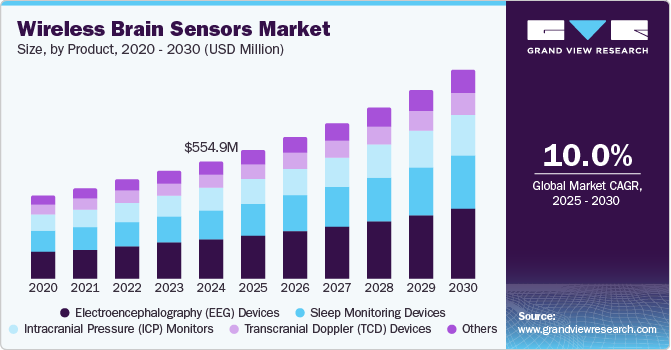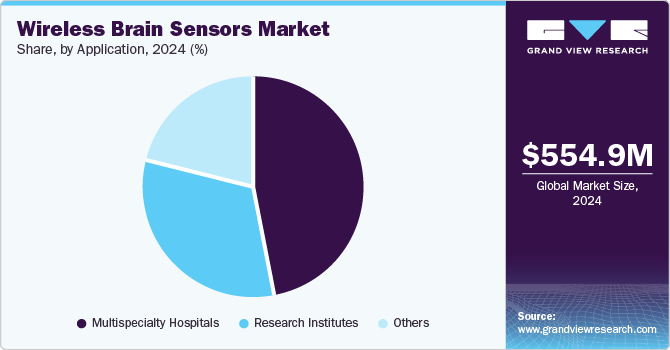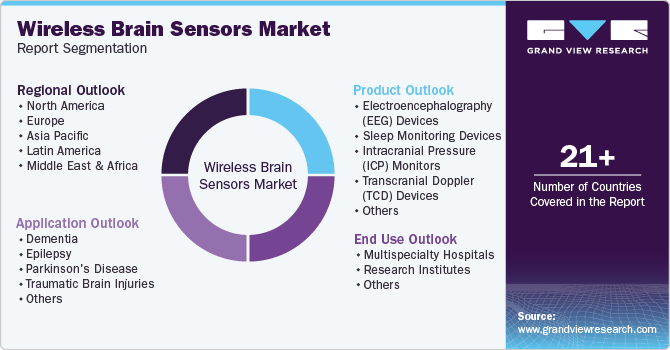
Wireless Brain Sensors Market Size, Share & Trends Analysis Report By Product (EEG Devices, ICP Monitors, TCD Devices), By Application (Dementia, Epilepsy, TBI), By End Use, By Region, And Segment Forecasts, 2025 - 2030
- Report ID: GVR-4-68039-083-5
- Number of Report Pages: 100
- Format: PDF
- Historical Range: 2018 - 2023
- Forecast Period: 2025 - 2030
- Industry: Healthcare
Wireless Brain Sensors Market Trends
The global wireless brain sensors market size was estimated at USD 554.9 million in 2024 and is expected to grow at a CAGR of 10.0% from 2025 to 2030. The increasing adoption of sedentary lifestyles worldwide is one of the major factors driving the market for wireless brain sensors. Unhealthy lifestyle choices such as alcohol addiction and smoking are among the major causes of stroke and migraine.

Stroke is the leading cause of mortality and morbidity due to the adoption of an unhealthy lifestyle. In the U.S., around 70,000 people suffer from stroke every year, out of which 23.0% of strokes are fatal or cause permanent disability. In addition, smoking is another major risk factor that causes hemorrhagic and ischemic stroke. Since wireless brain sensors help to manage and prevent such conditions, increasing the adoption of unhealthy lifestyle habits is likely to boost the market for wireless brain sensors.
The rising number of Traumatic Brain Injuries (TBI) cases is also one of the major drivers positively influencing the market's growth for wireless brain sensors. TBIs, due to a blow, bump, or shock to the skull, cause permanent or temporary impairment of the brain. Major causes of TBIs include sports injuries, falls, gunshot wounds, domestic violence, and road traffic accidents. TBI is one of the leading causes of morbidity and mortality and a major public health concern in developed and developing countries.
In addition, the number of road accidents is rapidly increasing, leading to a rise in the need for wireless brain sensors. According to the World Health Organization (WHO) 2023, around 20 to 50 million people are injured or disabled every year, and 1.19 million people die in road accidents. Road traffic injuries are estimated to be the ninth leading cause of mortality globally. ASIRT also reported that in the U.S., more than 38,000 people die in road accidents per year, and around 4.4 million are injured or disabled.
According to the Ministry of Road Transport and Highways, Government of India, in 2022, around 4,43,366 people were injured in road accidents. The number of injured patients from road accidents has increased by 15.3% from 2021 to 2022. In 2022, Tamil Nadu (64,105) and Madhya Pradesh (54,432) recorded the highest number of road accidents. This is anticipated to propel the market's growth for wireless brain sensors over the forecast period. Moreover, according to the CDC, in the U.S., falls (52.0%) and road accidents (20.0%) are the first and second leading causes of all TBI-related hospitalizations, respectively. Thus, increasing incidences of road accidents and falls are expected to fuel the market's growth for wireless brain sensors during the forecast period.
The global acceptance of sedentary lifestyles is one of the key factors propelling the market for wireless brain sensors. Numerous unhealthy lifestyle choices, such as smoking and alcohol, lead to stroke and migraine. In addition, the market for wireless brain sensors is expected to witness an increase in demand due to the rising occurrence of traumatic brain injuries (TBI). A hit, bump, or shock to the head that results in temporary or permanent brain injury is what causes TBIs. Gunshot wounds frequently bring on TBIs, falls, domestic abuse, and automobile accidents, among other things.
In addition, the rise in traffic accidents is fueling demand for wireless brain sensors and accelerating the market's expansion. The rising incidence of neurological illnesses such as Parkinson's disease, Alzheimer's disease, epilepsy, and others is a crucial factor contributing to the industry's rise. Moreover, rising healthcare spending capacity and improvements in healthcare infrastructure are the main factors expected to accelerate market expansion.
Product Insights
The electroencephalography (EEG) devices segment dominated the market for wireless brain sensors and held the largest revenue share of 33% in 2024. It is expected to grow at the fastest CAGR of 10.5% over the forecast period. The EEG devices allow the recording of electrical activity in the brain. The device helps collect electrical activity in the brain. The collected signals are digitalized and amplified and are then sent to mobile or computer for data processing and storage. Individuals can also use this device to improve their wellness and productivity by monitoring their emotions and mood.
The sleep monitoring devices segment is anticipated to grow significantly, with a CAGR of 10.2% from 2025 to 2030.The rising prevalence of sleep disorders is expected to increase the use of sleep-tracking devices. For instance, according to the United Health Foundation, in 2022, 35.5% of American adults stated that they slept less than seven hours in 24 hours. In addition, a report published in 2024 by the National Council on Aging, Inc. revealed that around 30% of adults experience symptoms of insomnia, with 10% having insomnia that affects their daily activities. The population affected by sleep apnea ranges from 9% to 38%, per the same report. Increasing cases of sleep apnea and insomnia across the globe are driving market growth.
End Use Insights
The multispecialty hospitals segment dominated the wireless brain sensors market and held the largest revenue share of 46.9% in 2024 and is expected to grow at the fastest CAGR of 10.7% over the forecast period. The increasing cases of stroke and traumatic brain injuries are the major driving factors for the segment. According to the Centers for Disease Control and Prevention (CDC), in 2020, there were approximately 214,110 TBI-related hospitalizations and 69,473 TBI-related deaths, representing more than 586 TBI-related hospitalizations and 190 TBI-related deaths per day. Hospitalization rates and death rates were the highest among individuals aged 75 and older. Moreover, it was seen that males were nearly two times more likely to be hospitalized and three times more likely to die from a TBI than females.
The research Institutes segment is anticipated to grow significantly, with a CAGR of 10.0% from 2024 to 2030. The market is experiencing rapid growth due to the increasing focus on neuroscience research, escalating investment in funding initiatives, and breakthrough innovations in brain monitoring technologies.
Research Institutions are heavily investing in wireless brain sensor technologies, aiming to unravel the complexities of neurological disorders and develop innovative treatment solutions. The rising incidence of neurological disorders, including Alzheimer's, Parkinson's, and epilepsy, is further accelerating the market growth.
Application Insights
The traumatic brain injuries segment held a significant share in the market, with a revenue share of 30.9% in 2024, and is also expected to witness the fastest growth, with a CAGR of 10.1% from 2025 to 2030 in the market for wireless brain sensors. Rising awareness regarding TBIs and the increasing prevalence of TBIs are the major factors boosting segment growth in the market for wireless brain sensors.

According to a report published by the CDC in 2020, around 1.5 million Americans suffering from TBI are treated every year. The rising number of people participating in sports and recreational activities is also expected to increase the volume of patients suffering from various brain injuries. According to Stanford Children's Health, over 3.5 million injuries are reported annually among children and teens in the U.S., and around 21.0% of all injuries are TBIs. Furthermore, according to the National Safety Council 2023 report, 3.7 million people were treated in emergency departments for injuries involving sports and recreational equipment. The activities most frequently associated with injuries are exercise, cycling, and basketball.
Regional Insights
North America wireless brain sensors market dominated the market and accounted for the largest revenue share of 46.2% in 2024. The growth in this region is driven by the increasing prevalence of neurological disorders, such as traumatic brain injuries and Alzheimer's disease. A robust healthcare infrastructure that supports advanced medical technologies further enhances market expansion. The demand for minimally invasive monitoring solutions is rising, reflecting a shift towards personalized healthcare. Continued advancements in research and development are expected to lead to innovations in wireless brain sensors, improving their applications in both clinical and home settings.

U.S. Wireless Brain Sensors Market Trends
The U.S. wireless brain sensors market is experiencing robust growth, driven by advancements in neuroscience research, the increasing prevalence of neurological disorders, and the demand for non-invasive diagnostic solutions. These sensors, designed to monitor brain activity in real time, are gaining traction in applications like epilepsy management, traumatic brain injury diagnosis, and mental health monitoring. Innovations in wireless technology and miniaturization are enhancing the sensors’ accuracy and usability, making them more accessible for both clinical and research purposes. In addition, rising investments in healthcare technology and growing brain health awareness are driving significant developments in the wireless brain sensors industry.
Mexico Wireless Brain Sensors Market Trends
Mexico wireless brain sensors market is projected to grow at the highest CAGR of 11.7% during the forecast period. This growth is fueled by an increasing focus on addressing neurological disorders, such as Alzheimer’s disease and traumatic brain injuries, which are becoming more prevalent in the region. The demand for advanced, non-invasive monitoring solutions continues to rise as healthcare providers prioritize accurate diagnosis and effective treatment options. Furthermore, integrating innovative technologies in medical settings significantly improves patient care and outcomes. Supportive regulatory frameworks and the entry of new players are intensifying competition and driving innovation, solidifying Mexico's role as a growing force in the wireless brain sensors industry.
Europe Wireless Brain Sensors Market Trends
Europe wireless brain sensors market is expected to witness considerable growth over the forecast period. Key drivers for this growth are the region’s rapid technological advancements, increasing government investment in brain research initiatives, and a relatively streamlined regulatory framework facilitating market entry. The presence of a large target population and high unmet needs for minimally invasive techniques are expected to present significant growth opportunities for the key players operating in the market for wireless brain sensors.
Moreover, an increase in the number of clinical trials and high R&D investments by global market players, owing to low-cost services in the region, are high-impact rendering drivers of the wireless brain sensors industry market. However, the low adoption of advanced healthcare facilities, lack of skilled professionals, and poor healthcare reimbursement facilities in some of the countries in this region may hinder the market growth for wireless brain sensors.
Germany wireless brain sensors market is set for substantial growth, driven by the increasing prevalence of neurological disorders and the rising demand for non-invasive monitoring solutions. Advancements in sensor technology, miniaturization, and integration with artificial intelligence are key factors driving market expansion. Moreover, the growing adoption of wearable devices and telemedicine is expected to further boost demand. The market is witnessing a surge in the development of innovative wireless brain sensors for applications such as epilepsy monitoring, sleep disorder diagnosis, and brain-computer interfaces, solidifying its role in the wireless brain sensors industry.
Key Wireless Brain Sensors Company Insights
The wireless brain sensors market is characterized by significant advancements and investments aimed at enhancing neurotechnology solutions. Some key players in this industry are EMOTIV, Advanced Brain Monitoring, Inc., and NeuroSky. These companies are engaged in the development of advanced brain-computer interface (BCI) technologies, which have various applications in the healthcare sector.
-
EMOTIV is actively involved in the development of wearable EEG devices that facilitate brain activity monitoring for both clinical and consumer applications. The company emphasizes research collaborations to enhance the capabilities of its products in neurofeedback and mental health assessment.
-
Advanced Brain Monitoring, Inc. focuses on creating advanced sleep monitoring devices that leverage wireless brain sensors to provide insights into sleep patterns and disorders. Their products are designed to integrate seamlessly into clinical settings, improving patient care through enhanced data collection.
Key Wireless Brain Sensors Companies:
The following are the leading companies in the wireless brain sensors market. These companies collectively hold the largest market share and dictate industry trends.
- EMOTIV
- Advanced Brain Monitoring, Inc.
- NeuroSky
- Neuroelectrics
- Neuronetrix Solutions, LLC (dba COGNISION)
Recent Developments
-
In May 2021, Neuroelectrics, a leader in brain stimulation technology development, raised USD 17.5 million in a Series A round led by Morningside Ventures. The fund was expected to be used to develop the non-invasive transcranial electrical stimulation (tES) technology.
Wireless Brain Sensors Market Report Scope
|
Report Attribute |
Details |
|
Market size value in 2025 |
USD 607.5 million |
|
Revenue Forecast in 2030 |
USD 979.6 million |
|
Growth Rate |
CAGR of 10.0% from 2025 to 2030 |
|
Base year for estimation |
2024 |
|
Historical data |
2018 - 2023 |
|
Forecast period |
2025 - 2030 |
|
Report updated |
December 2024 |
|
Quantitative units |
Revenue in USD Million and CAGR from 2025 to 2030 |
|
Report Coverage |
Revenue forecast, company ranking, competitive landscape, growth factors, and trends |
|
Segments Covered |
Product, Application, End Use, Region |
|
Regional scope |
North America; Europe; Asia Pacific; Latin America; MEA |
|
Country scope |
U.S.; Canada; Mexico; Germany; UK; France; Italy; Spain; Denmark; Sweden; Norway; Japan; China; India; Australia; Thailand; South Korea; Brazil; Saudi Arabia; UAE; South Africa; Kuwait |
|
Key companies profiled |
EMOTIV; Advanced Brain Monitoring, Inc; NeuroSky; Neuroelectrics; Neuronetrix Solutions, LLC |
|
Customization scope |
Free report customization (equivalent to 8 analyst’s working days) with purchase. Addition or alteration to country, regional & segment scope. |
|
Pricing and purchase options |
Avail customized purchase options to meet your exact research needs. Explore purchase options |
Global Wireless Brain Sensors Market Segmentation
This report forecasts revenue growth at global, regional, and country levels and provides an analysis of the latest industry trends in each of the sub-segments from 2018 to 2030. For the purpose of this study, Grand View Research has segmented the global wireless brain sensors market report on the basis of product, application, end use, and region:

-
Product Outlook (Revenue, USD Million, 2018 - 2030)
-
Electroencephalography (EEG) Devices
-
Sleep Monitoring Devices
-
Intracranial Pressure (ICP) Monitors
-
Transcranial Doppler (TCD) Devices
-
Others
-
-
Application Outlook (Revenue, USD Million, 2018 - 2030)
-
Dementia
-
Epilepsy
-
Parkinson's Disease
-
Traumatic Brain Injuries
-
Others
-
-
End Use Outlook (Revenue, USD Million, 2018 - 2030)
-
Multispecialty Hospitals
-
Research Institutes
-
Others
-
-
Regional Outlook (Revenue, USD Million, 2018- 2030)
-
North America
-
U.S.
-
Canada
-
Mexico
-
-
Europe
-
Germany
-
UK
-
France
-
Italy
-
Spain
-
Denmark
-
Sweden
-
Norway
-
-
Asia Pacific
-
Japan
-
China
-
India
-
Australia
-
Thailand
-
South Korea
-
-
Latin America
-
Brazil
-
-
Middle East and Africa (MEA)
-
Saudi Arabia
-
UAE
-
South Africa
-
Kuwait
-
-
We are committed towards customer satisfaction, and quality service.
"The quality of research they have done for us has been excellent."





